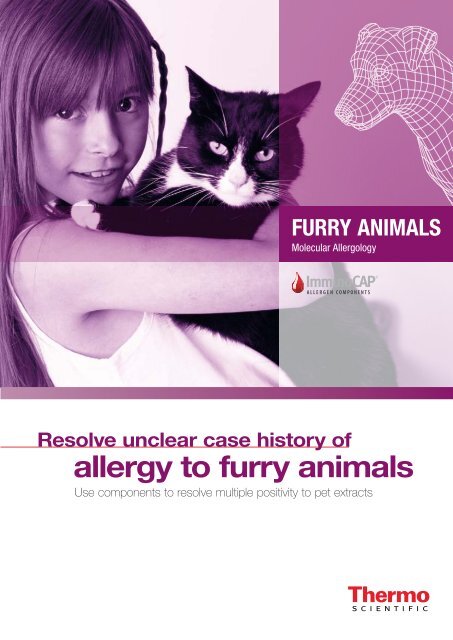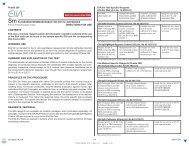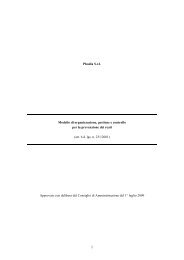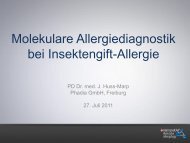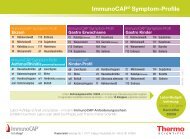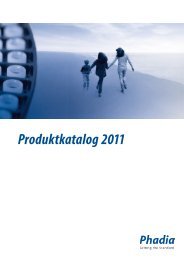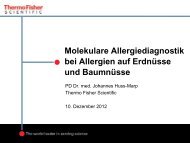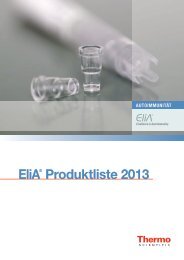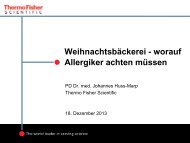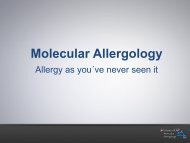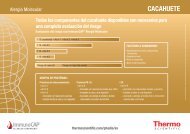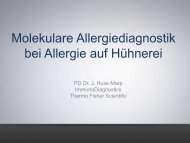Download: 891.8 KB - Phadia
Download: 891.8 KB - Phadia
Download: 891.8 KB - Phadia
Create successful ePaper yourself
Turn your PDF publications into a flip-book with our unique Google optimized e-Paper software.
FURRY AnimalsMolecular AllergologyResolve unclear case history ofallergy to furry animalsUse components to resolve multiple positivity to pet extracts
Use components to resolve multiplepositivity to pet extractsThe case history of pet allergic patients does not always clearly suggest which animal(s) is causingthe symptoms. Furthermore, many patients allergic to furry animals are positive to several pet danderextracts such as cat, dog and horse. 1, 2Complete natural extracts detect sensitization to pets with high efficiency and sensitivity: 3• Cat dander: e1• Dog dander: e5• Horse dander: e3Components can help explain multiple positive pet extract tests and clarify: 1, 2• True co-sensitization to cat, dog and horse• Cross-reactivity between serum albuminsSpecific pet components discriminate between true sensitization to one/several pets: 1, 2• Specific cat components: Fel d 1, Fel d 4*• Specific dog components: Can f 1, Can f 2, Can f 5• Specific horse component: Equ c 11, 2, 4Cross-reactive pet components explain cross-reactivity:• Serum albumins: cat component Fel d 2, dog component Can f 3• Serum albumins are present in all mammals and have similar protein structure between species*See lipocalin explanation under ”Did you know that?”
Suggested test profilesImmunoCAP ®COMPLETE EXTRACTSCATe1HORSEe3ImmunoCAP ®Allergen COMPONENTSFel d 1, Fel d 2, Fel d 4NEWFel d 1 Fel d 2 Fel d 4Secretoglobin Serum albumin LipocalinEqu c 1LipocalinNEWImmunoCAP ®COMPLETE EXTRACTSDOGe5ImmunoCAP ®Allergen COMPONENTSCan f 1, Can f 2, Can f 3, Can f 5Can f 1 Can f 2 Can f 3 Can f 5NEWLipocalinLipocalinSerum albuminArginine esteraseIgE levels indicate primary sensitizationWhen IgE antibodies to two or more cross-reactingcomponents are detected, the primary sensitizer isgenerally indicated by the highest IgE levels.In this case, IgE antibodies to both cat Fel d 2 and dogCan f 3 serum albumins are detected. Here, the catis most likely the primary sensitizer driving the symptoms,since the levels of IgE to Fel d 2 is much higherthan the IgE levels to Can f 3.IgE level (kU A /I)Fel d 1Fel d 2Can f 3
Did you know that?Pet allergy• Cat and dog allergens are among the most important indoor allergens 8, 9• Pet allergic subjects present mainly with rhinitis and asthma symptoms 8, 9• As many as about 60–70 % of animal allergic patients are co-sensitized to several petssuch as cat, dog and horse, suggesting strong comorbidity and/or prevalent cross-reactivity 1Cat allergy• Fel d 1 is the major cat allergen component and about 60–90 % of cat allergic subjectshave IgE antibodies to Fel d 1 9–11• High IgE levels to Fel d 1 is a risk factor for development of asthma 109, 12• Fel d 4 IgE antibodies are detected in about 60 % of cat allergic subjects, often at low IgE levels• Fel d 2 is a cross-reactive serum albumin regarded as a minor cat allergen, and about 15–40 %2, 9, 11, 13, 14of cat allergic patients are sensitized to Fel d 2Dog allergy2, 15–17• Can f 1, Can f 2 and Can f 5 are all specific dog allergen components• About 50–90 %, 20–30 % and up to 70 % of dog allergic subjects are sensitized to Can f 1,2, 15–17Can f 2 and Can f 5, respectively• Can f 3 is the cross-reactive dog serum albumin. IgE to Can f 3 is detected in about 15–50 %2, 4, 14of dog allergic patientsHorse allergy• Equ c 1 is a major horse allergen component. About 75 % of horse allergic subjects are sensitizedto Equ c 1 19• Generally lipocalins are of low protein similarity. However, certain lipocalins share significant sequence12, 20similarity and display some level of cross-reactivity, for example horse Equ c 1 and cat Fel d 4
Find out more about allergy to furry animalsto improve patient managementDefine primary sensitizer(s) and understand cross-reactions to pets to: 1, 2• Improve pet allergen avoidance advice• Facilitate identification of patients and selection of appropriate extracts for immunotherapyBenefits in patient management 5–7Well-founded pet allergen avoidance and proper immunotherapy can:• Reduce allergic symptoms• Relieve the patient from fear of unexpected severe reactions in social life and daily activities• Improve the quality of life of pet-allergic patients
Make a precise assessmentImmunoCAP Allergen components help you differentiate between ”true” allergiesand cross-reactivityMake a substantiated decisionA better differentiation helps you give relevant advice and define the optimal treatmentMake a differenceMore informed management helps you improve the patient’s well-being and quality of lifeReferences: 1. Borres MP et al. Ped Allergy Immunol 2011; 22: 454–461. 2. Sastre J. Clin Exp Allergy 2010; 40: 1442–1460. 3. Paganelli R et al. Allergy 1998; 53(8): 763–768.4. Liccardi G et al. Curr Allergy Asthma Rep 2011; 11(5): 421–426. 5. Platts-Mills TA. J Allergy Clin Immunology 2004; 113: 388–391. 6. Nanda AM et al. J Allergy Clin Immunol2004; 114(6): 1339–1344. 7. Lent AM et al. J Allergy Clin Immunol 2006; 118(6): 1249–1256. 8. Simpson A et al. J Allergy Clin Immunol 2005; 116: 744–749. 9. Grönlund H etal. Int Arch Allergy Immunol 2010; 151: 265–274. 10. Grönlund H et al. Clin Exp Allergy 2008; 38: 1275–1281. 11. van Ree R et al. J Allergy Clin Immunol 1999; 104: 1223–1230.12. Smith W et al. Clin Exp Allergy 2004; 34: 1732–1738. 13. Cabanas R et al. Invest Allergy Clin Immunol 2000; 10(2): 71–77. 14. Spitzauer S et al. J Allergy Clin Immunol1995; 96: 951–959. 15. Mattsson L et al. J Allergy Clin Immunol 2009; 123: 362–368. 16. Kamata Y et al. Int Arch Allergy Immunol 2007; 142: 291–300. 17. Saareleinen S et al.Clin Exp Allergy 2004; 34: 1576–1582. 18. Mattsson L et al. Clin Exp Allergy 2010; 40: 1276–1287. 19. Saareleinen S et al. Clin Exp Allergy 2008; 38(2): 374–381. 20. MattssonL et al. Abstract #1382, 29th EAACI Congress, 2010, London.thermoscientific.com/phadia© 2012 Thermo Fisher Scientific Inc. All rights reserved. All trademarks are the property of Thermo Fisher Scientific Inc. and its subsidiaries.Manufacturer; <strong>Phadia</strong> AB, Uppsala Sweden.Head office Sweden +46 18 16 50 00Austria +43 1 270 20 20Belgium +32 2 749 55 15Brazil + 55 11 3345 5050China +86 25 8960 5700Czech Republic +420 220 518 743Denmark +45 70 23 33 06Finland +358 9 3291 0110France +33 1 61 37 34 3052-5108-92 951-2100 1211 heart.seGermany +49 761 47 8050Hong Kong +852 2885 4613India +91 11 4610 7555/56Italy +39 02 64 163 411Japan +81 3 5365 8332Korea +82 2 2027 5400Norway +47 21 67 32 80Portugal +351 21 423 5350South Africa +27 11 792 6790Spain +34 935 765 800Sweden +46 18 16 60 60Switzerland +41 43 343 4050Taiwan +886 2 2516 0925The Netherlands +31 30 602 37 00United Kingdom/Ireland +44 1 908 769 110USA +1 800 346 4364Other countries +46 18 16 50 00


